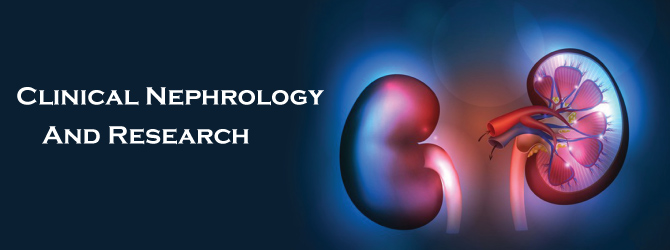Obesity and the relationship between chronic kidney diseases
Received: 01-Jan-2024, Manuscript No. PULCNR-24-6008; Editor assigned: 02-Jan-2024, Pre QC No. PULCNR-24-6008 (PQ); Accepted Date: Jan 18, 2024; Reviewed: 16-Jan-2024 QC No. PULCNR-23-6008; Revised: 01-Mar-2024, Manuscript No. PULCNR-24-6008 (R); Published: 01-Feb-2024
Citation: Garcia R. Obesity and the relationship between chronic kidney diseases. Clin Nephrol Res 2023;7(1):1.
This open-access article is distributed under the terms of the Creative Commons Attribution Non-Commercial License (CC BY-NC) (http://creativecommons.org/licenses/by-nc/4.0/), which permits reuse, distribution and reproduction of the article, provided that the original work is properly cited and the reuse is restricted to noncommercial purposes. For commercial reuse, contact reprints@pulsus.com
Introduction
A major obstacle to the prevention of chronic diseases in people worldwide is the extensive development of obesity. Supported by economic expansion, mechanised transportation, an increase in sedentary behaviour, and a trend away from a healthy, balanced diet toward processed foods and high calorie diets like fast food and sugary drinks. Many countries, whether wealthy or emerging countries, have seen a doubling or even an exponential increase in the frequency of obesity among their citizens. Obesity and CKD rates have increased concurrently during the past few years, and they have done so globally. As a result, it has become a sickness to be concerned about.
Despite its many facets, obesity is ultimately an illness that may be avoided. It is a white fat (white adipose tissue) systemic disorder that has become a major global health issue. It is associated with disturbances in adipocyte hormones (adipokines), the energy-balance system, and metabolic homeostasis. Simply explained, it's a condition that causes excessive body fat and increases the risk of developing future health issues.
Description
According to biochemistry, obesity is primarily caused by an excessive buildup of triacylglycerols in fatty tissue, which is the end result of daily energy intake that is higher than daily energy expenditure. Chronic illness morbidity, such as immobility, depression, type II diabetes, cardiovascular diseases, etc., is considerably increased. Childhood obesity causes the same issues to manifest earlier and even more often in maturity.
Free fatty acids and adipokines harmful metabolic actions combine to form the pathophysiology of these diseases. Our current knowledge gaps are not primarily related to the quantity of threat components or to their separate effects on threat; rather, it is more crucial to understand how they interact. The result of our body's energy imbalance is obesity.
Simply explained, obesity results from consuming more calories than the body burns exercise and daily activities, leaving the body with surplus energy and a condition of positive energy balance. This energy imbalance leads to significant societal and financial changes that are much beyond one's capacity to influence.
Obesity primarily results from acquired and congenital/genetic causes.
Acquired causes: Since children's physical activity levels have significantly dropped, obesity has been linked to children's excessive energy intake in the form of fat or carbohydrates. Other variables, such as low birth weight during infancy, can also contribute to obesity in later life. Truncal/visceral obesity is also associated to Cushing's syndrome, albeit it can be difficult to distinguish from regular obesity. However, a slight decrease in energy expenditure caused by hypothyroidism can also contribute to weight gain. Typically, signals from the gastrointestinal tract and adipose tissue are combined in the Central Nervous System (CNS) to act on hunger and energy homeostasis that limits weight gain. However, pathological obesity can be a possible result of the failure of these homeostasis systems.
Hippocrates asserted that "unexpected demise is more common in naturally obese individuals as compared to the thin ones," which supports the idea that very few people are born with a hereditary inclination for obesity. Congenital/genetic causes but why would nature allows such genes to exist? Perhaps some populations had genes that dictated better fat storage, which gave them an advantage during times of scarcity, but in the present, this just leads to type-2 DM and obesity. It appears that numerous genes with a mild influence contribute to a person's susceptibility to the more prevalent forms of obesity, with the exception of the uncommon mutations causing acute morbid obesity.
An illustration would be the adiponectin gene, a peptide produced by adipocytes that regulates glucose, lipid, and energy homeostasis. Normal weight loss is caused by high levels of adiponectin, however obesity and insulin sensitivity have also been linked to variants of this gene.
One of the main causes of obesity is osteoarthritis, which is especially common in the ankles and knees, where it is immediately linked to trauma from levels of excess body weight. However, changed cartilage and bone metabolism can still have an impact on joints that don't support weight.
Although smoking and obesity are both considered to be the second most preventable causes of mortality, a recent study found that the expenses associated with treating obesity are higher than those associated with treating smoking. Typically, obesity may be self-diagnosed and self-treated. A person is considered obese by the WHO if their BMI (Body Mass Index) is 30 or more. Treatment entails self-care practices like yoga, exercise, weight loss, and a low carb, high fat diet.
Simply put, CKD refers to conditions that damage the kidneys or renal system while also impairing their ability to maintain our health by carrying out their function. By products accumulate to remarkable quantities in plasma as renal disease worsens, finally causing anaemia, weak bones, poor health, and nerve damage. Additionally, it raises the risk of difficulties in later life, such as heart and blood vessel illnesses.
Simply put, the kidneys filter waste products (byproducts) and extra fluid from the plasma. Renal failure is brought on by the accumulation of waste products and chronic kidney disorders.
Conclusion
Nearly two thirds of cases of chronic kidney disease are brought on by diabetes, high blood pressure, and other conditions. Glomerulonephritis, inherited disorders (such as polycystic kidney disease), and deformities that arise in developing foetuses while they are still inside their mother's womb are additional conditions that affect the kidneys. obstructions brought on by kidney stones, tumours, or in men, an enlarged prostate gland. Despite recent managerial advancements, it is spreading like an epidemic.





